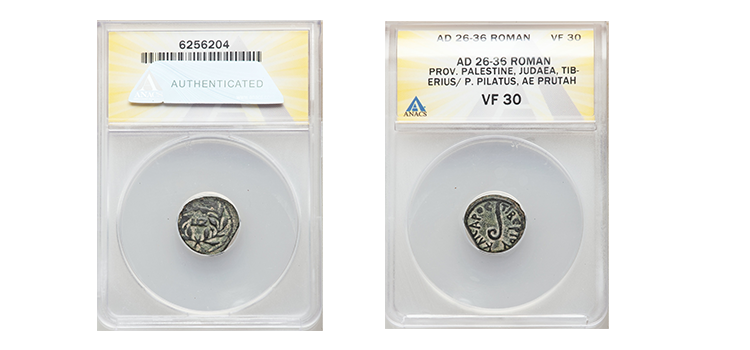Prutah of Pontius Pilate
Many of the Roman prefects of the province of Judea issued their own coinage. Because of his connection to Jesus Christ, the prutah of Pontius Pilot are among the most coveted.

Pilate’s Rule Over Judea
Pontius Pilate was the Roman prefect (or governor) of Judaea under Emperor Tiberius, ruling from 26/27 to 36/37 A.D. Under his rule, the relationship between the Romans and the Jews became increasingly volatile, in large part due to effort by Pilate to antagonize the Jews. Jewish philosopher Philo wrote that Pilate was “…inflexible, merciless and obstinate…(and did not) wish to do anything that would please his subjects.”
Pilate presided at the trial of Jesus and ordered his crucifixion. As described in the Bible, Matthew 21: 1-2: “When morning came, all the chief priests and elders of the people plotted against Jesus to put Him to death. And when they had bound Him, they led Him away and delivered Him to Pontius Pilate the governor.”
Roman Procurator Coinage
The Roman Procurators and Prefects of the province of Judea issued bronze prutah between 6 – 66 A.D. In Hebrew, prutah means “a coin of smaller value.” The coins was worth approximately one thousandth of a pound, and it cost about 10 prutot to buy a loaf of bread at that time. Not all of the Procurators issued coinage. Those that did included Coponius, Marcus Ambivulus, Valerius Gratus, Pontius Pilate, Antonius Felix and Porcius Festus, who between them issued a total of 19 different coins.
Unlike other Roman coins, those minted by the Judaean prefects and procurators did not depict members of the royal family, likely because the Jews viewed coins bearing the image of Roman rulers as an attack on their religion. However, the Jews likely did not approve of Pilate’s designs. His coinage featured the simpulum and lituus, which were representative of the pagan imperial cult. The lituus was a ritualistic wand, which was used by augurs (Roman priests) to study natural phenomenon, such as the flight of birds, and assess the divine approval or disapproval of a proposed action. The simpulum, a ladle used to make libations during sacrifices, was also associated with the ancient Roman priesthood.
The coins were minted in Jerusalem. The design of the prutah of Pontius took two forms. The obverse of the one minted between A.D. 29 and 30 featured three bound ears of barley surrounded by the inscription IOVLIAC KAICAPOC. The reverse depicted a simpulum surrounded by the inscription TIBERIOY KAICAPOC LIV, which means [coin] of Emperor Tiberius.
The second coin design, dated to years 17 (A.D. 30 to 31) and 18 (A.D. 31 to 32), featured a lituus surrounded by the inscription TIBERIOY KAICAPOC on the obverse. The reverse included the date surrounded by a wreath.
